Blueberries - growing in Ukraine: from planting to leaving
Blueberry belongs to the genus Vaccinium of the Heather family. This plant does not lend itself to cultivation and the creation of new varieties. Close to blueberries are blueberries, which are increasingly found in home gardens and industrial gardens. Both crops are valued for the pleasant taste of the fruit and the healing properties. Blueberries are considered by many to be a type of blueberry. Therefore, some varieties have a double name, including both types of berries.
Content:
- Description and the best varieties of shrub
- Breeding features
- Everything you need to know about boarding
- Blueberry care
- Using blueberries
Description and the best varieties of shrub
Bilberry is a low (25-50 cm) deciduous shrub with ribbed branches, small rounded finely serrated leaves and underground stolon shoots, the length of which sometimes exceeds 10 m. The root system of blueberries, like all heathers, is in symbiosis with the fungus. Blossoms in May with small single green-pink drooping flowers in the form of a jug. They are located in the axils of the upper leaves on short stalks. Blooms from May to June for about 15 days.
After pollination by bees, fruits of 6-12 mm in size are formed in place of flowers.
Forest berries ripen in the middle of summer. There is a noticeable rounded scar at the top of the fruit. Fruit color is dark blue, almost black. From above, they are covered with a gray waxy bloom, which contains a small amount of essential oils. There are varieties with shiny black fruits without bloom.
The pulp is purple inside. She paints her hands for a long time. It blooms and bears fruit from 3 to 15 years after planting. Maximum yield in 7-year-old bushes. Forest blueberries, unlike blueberries, do not lend themselves to cultivation and breeding of new varieties. The varieties that are grown under the name "garden blueberry" are more likely blueberries. They belong to the same genus and family, have much in common in composition and properties.
There are some differences between blueberries and blueberries. Blueberries are red inside, blueberries are greenish. Therefore, they do not leave marks on the hands. Blueberry in nature it can be found in pine forests, blueberries in peat bogs. Blueberries are slightly larger. All varieties of garden blueberries (blueberries) are divided into early, ripening in July, medium and late, harvested in September or early October.
Varieties:
- Blue Gold is 1.2 m high. Needs regular pruning. The sweet and tasty fruit ripens in early August. You can collect 10 kg of berries from a bush. Resistant to diseases, not afraid of frost.
- Toro blueberries (American blueberries) are distinguished by large, juicy blue fruits, collected in dense clusters. They ripen at the same time, easily detach from the stalk. The height of the compact bush reaches 2 m. In spring, it is covered with white or pink flowers. Does not require pollinators, but planting another variety of bushes next to it increases yields. In autumn, the leaves take on a beautiful bronze tint.
- Blue Crop is a low bush covered with large hard fruits 18 mm long. The color of the fragrant berries is light blue, the shape is flattened. Productivity up to 7 kg. Fruiting is regular. The bush can withstand temperatures as low as -32 ° C. Disease resistant.
- Earley Blue is prized for its large, deliciously aromatic berries.The bush is high, one and a half meters away.
Breeding features
Blueberries can be propagated seeds or dividing the bush... To plant by seeds, you need to get them out of the fruit. To do this, they are ground and dipped in water. Grind there until pieces of pulp and small unripe seeds rise up. They are removed and the procedure is repeated again. Continue until the color of the water stops changing. Collect the seeds, dry them a little on a sheet of paper. Immediately sown into the ground to a depth of 7 mm.
The soil for sowing seeds is prepared from peat and river sand with the addition of crushed needles. Moisten slightly before planting. After sowing, the dishes are covered with glass. Control soil moisture. Seedlings will appear in weeks. They are transferred to a cool, bright room with a temperature of up to 10 ° C. In the spring dive in separate half-liter glasses. Young plants will live there for another year. Then you need to plant it in open ground.
From an adult bush, you can get several partial ones - associated with the mother plant.
They can be obtained from root suckers. Such bushes are separated from the mother plant and planted in a permanent place. Each of the young bushes must have at least 5 developed buds. It is better to plant in spring in October or early November, in spring - in April.
Everything you need to know about boarding
Blueberries and blueberries grow well on acidic soils... The acidity index is pH 3.5-5.0. If the indicator is less, the bushes begin to hurt. With a decrease in acidity, the yield of the bush decreases markedly. Acidic soils in Ukraine are more than 10 million hectares. This is mainly the Vinnitsa region. (80%), Kiev, Zhytomyr, Khmelnytsky regions. (up to 60%), Chernigov, Sumy, Cherkasy regions (up to 40%). Most crops grow poorly on such land. But for blueberries, such a soil is the most suitable.
Blueberries grow well in partial shade. When grown in sunny areas, the yield increases, but at the same time, the need for watering and regular irrigation increases. In the Carpathians, wild blueberries grow well in clearings and on the outskirts of the meadows. For the successful cultivation of blueberries, regions with warm, humid summers are chosen. The growing season for its development takes 5 months. This condition is fulfilled for all regions of Ukraine, including northern and western regions, where the climate is most suitable for growing crops. The winter temperature for most varieties should not drop for a long time beyond -28 ° C. Blueberries love moist, loose soil, but cannot tolerate stagnant water.
Features of planting blueberries:
- Pits for planting cuttings are prepared in advance, no later than a month before planting. It is easier to do this in areas with acidic soil. They dig holes with a depth and diameter of 50 cm.
- Mixed with 10 kg of sphagnum peat or sour deciduous humus. If the soil is not acidic enough, a part of low-lying peat is added to 2 parts of leafy land, river sand is added to the clay soil. Adding pine needles and oak leaves will be useful for blueberries.
- Sulfur powder will help to increase the acidity of the soil. On 1 m2, it is applied about 200 g. On poor sandy soils, fertilizers are applied to the entire area, or into pits with a diameter of 1.5 m.
- Put the resulting mixture in a pit. In a month, it will be compacted enough not to sag along with the planted bush, but it will be loose enough for growing roots.
- The bush is placed on the bottom of the pit, the roots are covered with earth and compacted. I water abundantly and mulch... For this, peat, coniferous sawdust, pine needles or cut grass are used.
- When planting bushes over 4 years old, they are cut off by 20 cm.The distance between bushes in a row is 1.5 m, row spacing is 2 m.
Unscrupulous sellers often sell wild blueberry seedlings with bare roots in the summer. They destroy entire plantations of this valuable crop, harming nature. It is not worth buying such plants, because they will not be able to take root even on acidic soil.You need to purchase bushes with a root ball of earth. Before planting, be sure to moisten and loosen it abundantly, leveling the roots.
Blueberry care
How to properly care for the bush:
- The planted bushes are regularly watered. Make sure that the soil under them is moist. Mulching will help retain moisture. You can increase the acidity of the soil with water with the addition of citric acid. When watering, 1 teaspoon is added to a bucket of water.
- You cannot get a good harvest without fertilizing. Reacts poorly to unripe manure. Therefore, every 2 years, 3 kg of humus per 1 m2 are introduced into the top layer. You can make complex mineral fertilizerschlorine free. Top dressing is carried out in early spring or autumn.
- Blueberry harvest depends a lot on proper pruning. They begin to carry out it from the age of three. Cut off dry and damaged shoots. A properly formed bush has 5 to 9 branches. Pruning is carried out at a height of 20 cm. The best time for the procedure is early spring. If you are late with pruning and do it before flowering, the yield will be lower. After the bush reaches 15 years of age, it ceases to bear fruit. It is removed or rejuvenated. To do this, in the spring, the trunk is cut off at a height of 20 cm.
- Blueberries are disease resistant. Sometimes some bushes are affected by rust. They must be removed so that the disease does not spread to neighboring plants.
- Forest birds are very fond of blueberries. They can become competitors to the owners, eating a significant part of the crop. Protection measures - installation of various deterrents, hanging bright or shiny objects. Blueberry roots can damage vole mice in winter. Therefore, for the winter, poison against rodents is spread around the perimeter of the plantation.
Ripe blueberries turn black or blue-violet. Most varieties do not reach at the same time. Therefore, they have to be collected every 5 days or once a week. This should be done carefully so as not to damage the peel. To do this, do not pull them, but turn them around the leg. The berries are placed in a thin layer in boxes.
Fresh fruits are more beneficial. Store the harvested blueberry can be stored in a cool place. At temperatures close to zero, they do not lose their presentation and stay up to 6 weeks.
Using blueberries
Blueberries are valued not so much for their taste as for their medicinal properties. They are due to the composition.
- The fruits of blueberries contain macroelements necessary for the human body: potassium (77 mg), phosphorus, magnesium, calcium, sodium.
- Among microelements, the first place belongs to manganese. In terms of its content, blueberries surpass all berry crops.
- Iron salts, which are part of the fruit, are absorbed much better than with the use of drugs.
- Copper promotes the development of bones, is involved in hematopoietic processes.
- Zinc promotes skin regeneration, improves immunity, selenium normalizes the thyroid gland,
- Vitamins A, C, E, K and PP, almost all B vitamins, organic acids, pectin, tannins, and sugar are part of the pulp of blueberries.
- Blueberries are prized for their high antioxidant content.
The use of blueberries in medicine:
- Thanks to its beneficial substances, blueberries are widely used in the treatment of eye diseases. Medicines are made from raw materials that preserve visual acuity, relieve eye fatigue, and treat conjunctivitis.
- In folk medicine, blueberries are used to treat disorders of the gastrointestinal tract, tonsillitis, pharyngitis, inflammation of the oral mucosa, and rheumatism.
- Eating fresh fruits cures scurvy.
- Lotions from the stems are used to treat ulcers, burns, eczema.
- A decoction of the leaves reduces blood pressure in hypertension.
- Blueberry leaves are used to make a drug that lowers blood sugar levels in the early stages of diabetes.
Blueberries are consumed fresh, dried for the winter, frozen in freezers.They are used to prepare juices rich in vitamins, delicious jams, marmalades. You can mix it with honey in equal proportions and store it in the refrigerator.
More information can be found in the video:
There are blueberries and contraindications:
- It is not advised to consume it fresh in large quantities. This can cause constipation.
- You can not use the fruits and juice from blueberries for patients with oxaluria - a type of urolithiasis.
- Individual intolerance to blueberries is very rare.
There are differences in the beneficial properties and contraindications of blueberries and blueberries. Blueberries have a stronger effect on the organs of vision, the growth of bones and teeth, and the functioning of the thyroid gland. Blueberries are better at lowering the level of bad cholesterol and protecting against cancer. Thrombophlebitis is a contraindication to taking large amounts of blueberries. It contains a substance that makes the blood thicker, which can lead to the formation of blood clots.



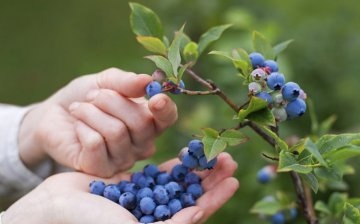



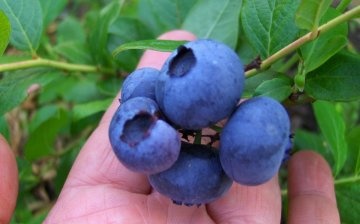







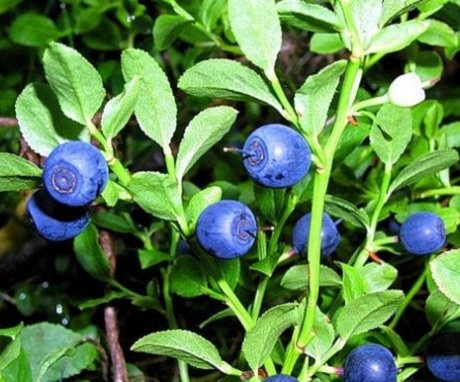
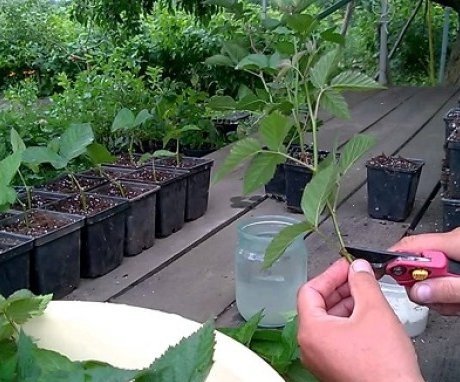


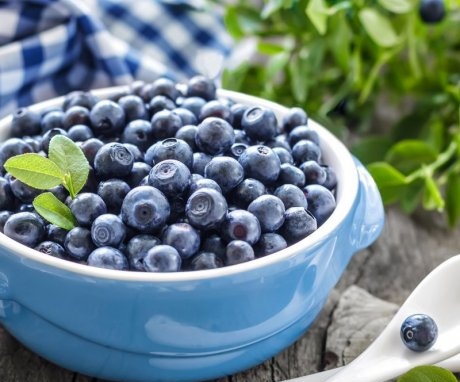
They tried to plant blueberries in our summer cottage. We tried to try different varieties for several years. Doesn't take root. The ground doesn't fit at all. And what is interesting, blueberries grow and bear fruit perfectly! It's all strange ...